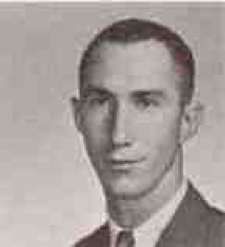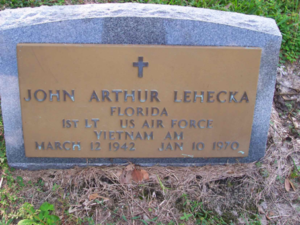Scroll of Honor – John LeHecka
Final Flight
John LeHecka graduated from high school in Rock Hill in 1960 and enrolled that fall at Clemson College.  An agronomy major, John remained in school through his sophomore year before joining the Peace Corps. He spent two years serving in East Pakistan, what is now Bangladesh. That experience, recalled his friend John Fuller, imbued LaHecka with greater maturity and thoughtfulness.
An agronomy major, John remained in school through his sophomore year before joining the Peace Corps. He spent two years serving in East Pakistan, what is now Bangladesh. That experience, recalled his friend John Fuller, imbued LaHecka with greater maturity and thoughtfulness.
Following his Peace Corps tour overseas, LaHecka returned to Clemson University in January 1965. In addition to resuming his agronomy courses, he also enrolled in advanced Air Force ROTC. John’s experiences overseas must have prepared him for new challenges, for as a senior, he served as a cadet lieutenant colonel and commandant of the Cadet Leadership School. He also found time to compete with the fencing club under the direction of architecture professor Hal Cooledge.
LaHecka graduated in December 1967 and was commissioned as a second lieutenant in the Air Force. He reported for active duty and pilot training to Craig Air Force Base near Selma, Alabama on January 15, 1968. John Fuller remembers meeting LaHecka when both were assigned to Hurlburt Field at Fort Walton Beach, Florida for Forward Air Controller (FAC) training. Located near Pensacola, the area featured “beautiful white beaches, fresh oysters, and cold beer,” wrote Fuller. “Our training program had about three weeks of content compressed into about three months.”
Upon leaving Florida, the training became more intense and more serious: Jungle Survival School at Clark  Air Force Base in the Philippines. The two lieutenants arrived at Tan Son Nhut Air Base, Vietnam on July 30, 1969 and were assigned to the 20th Tactical Air Support Squadron at Pleiku Air Base in the Central Highlands. Since neither officer had previous experience flying fighters, they were categorized as Class B FACs, meaning that, by prior agreement between the turf conscious Army and Air Force, they were not allowed to control airstrikes for American ground troops. As a result, LaHecka and Fuller found themselves flying out-country interdiction missions along the infamous Ho Chi Minh Trail along the borders of Laos, Cambodia and Vietnam.
Air Force Base in the Philippines. The two lieutenants arrived at Tan Son Nhut Air Base, Vietnam on July 30, 1969 and were assigned to the 20th Tactical Air Support Squadron at Pleiku Air Base in the Central Highlands. Since neither officer had previous experience flying fighters, they were categorized as Class B FACs, meaning that, by prior agreement between the turf conscious Army and Air Force, they were not allowed to control airstrikes for American ground troops. As a result, LaHecka and Fuller found themselves flying out-country interdiction missions along the infamous Ho Chi Minh Trail along the borders of Laos, Cambodia and Vietnam.
LaHecka was trained in night missions flying the O-2, the military version of the Cessna Skymaster, a twin-engine piston-powered aircraft with one engine in the nose and a second in the rear of the fuselage. One advantage of the O-2 was that its side window could be opened in flight allowing the navigator to use a Starlight Scope to help identify targets in the inky blackness of the jungle night.
After four months in country, LeHecka and Fuller were selected to fly highly classified Prairie Fire missions. Fuller remembered these as the unit’s “most demanding mission, even though it was always conducted in the day.” Prairie Fire sent Special Forces Long Range Reconnaissance Patrols (LRRP) into Laos and Cambodia to conduct reconnaissance operations and find downed airmen. LeHecka a

nd the other forward air controllers would coordinate fire support from Army Huey and Cobra helicopter gunships as well as Navy A-1 and Air Force F-4 fighters during the insertion and extraction of these LRRP teams.
On January 10, 1970, LeHecka and Fuller flew to Kontum, the base for the Special
Forces teams assignedto southern Laos. LeHecka picked up Sergeant First Class Sam Zumbrun, a highly decorated former medic now conducting reconnaissance missions for Prairie Fire. During their mission, LeHecka’s aircraft was struck by enemy small arms fire. LeHecka was killed and the luckless Zumbrun was stuck in a sophisticated aircraft without the skills to pilot it. Without a pilot, the plane crashed, killing Zumbrun. Both LeHecka’s and Zumbrun’s remains were recovered.
First Lieutenant John LeHecka was buried in the Lutz Cemetery, Lutz, Florida.  He was survived by his wife, the former Charlotte Featherson.
He was survived by his wife, the former Charlotte Featherson.
For more information about Lieutenant LeHecka see:
https://cualumni.clemson.edu/page.aspx?pid=1703
For additional information about Clemson University’s Scroll of Honor visit:
https://cualumni.clemson.edu/scrollofhonor
